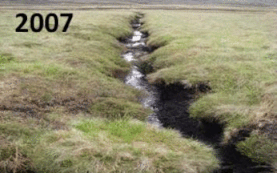
News
« Return to News8 March 2016
2016 SCaMP Monitoring Report Released
 United Utilities’ Sustainable Catchment Management Programme (SCaMP) is an innovative and large-scale project to improve catchment quality for nature conservation, raw drinking water, carbon retention and capture whilst ensuring a sustainable future for the agricultural tenants.
United Utilities’ Sustainable Catchment Management Programme (SCaMP) is an innovative and large-scale project to improve catchment quality for nature conservation, raw drinking water, carbon retention and capture whilst ensuring a sustainable future for the agricultural tenants.
The SCaMP monitoring programme has focused on botanical and hydrological effects across a range of habitats, with monitoring of peatland grip blocking and bare peat restoration.
The summary below covers the results of monitoring in Longdendale, Goyt and Bowland following restoration work up to 2015. The restoration measures in Longdendale involved large-scale re-vegetating of bare peat through the application of lime, fertiliser and a nurse grass mix both with and without heather brash and geojute (a geotextile) to stabilise the steeper bare peat slopes. In addition, removal of stock and some gully blocking, mostly using stone dams, were implemented. The restoration measures in Bowland and Goyt, in the Peak District, involved large-scale grip blocking, changes to stock levels and to managed burning programmes.
 Summary of Changes
Summary of Changes
After eight years of hydrological and water quality monitoring, the effects of SCaMP land management and interventions have had significant effects on water quality in key locations and, overall, the effects have been beneficial.
As each year passes and the SCaMP monitoring dataset expands it is easier to see trends in the data and to compare SCaMP data to other moorland management data sets from across the UK.
As a result of the SCaMP management intervention, the following trends can be seen:
• Colour production and delivery in streamflow appears to be largely stable or decreasing slightly within the long-term datasets, with the exception of two sites which show a slight increasing trend.
• Particulate organic carbon (measured as turbidity) levels continue to show rainfall event based responses. On bare peat restoration catchments the trends are more complex.
• On some catchments peat water table levels are now meeting the basic requirements for good quality blanket bog vegetation with elevated and more consistent levels as a result of grip blocking. However, data from some catchments indicate water table variations that indicate a continued susceptibility to dry weather years.
• The vegetation on some sites is moving towards a more diverse blanket bog community with more key species present, especially Sphagnum, along with other desirable blanket bog species. On bare peat restoration catchments, peat cover has reduced and there is some indication of the establishment of a more diverse vegetation community.
For further details, please contact us, or feel free to download the SCaMP 2016 monitoring report in full, or our 2016 SCaMP poster.

